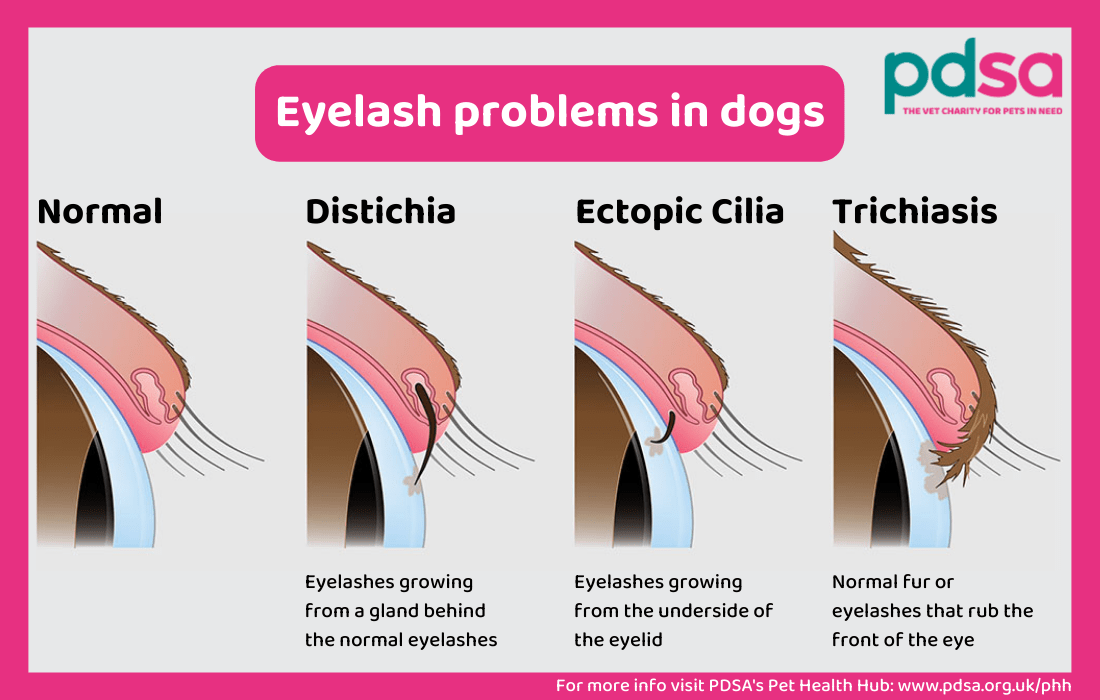Eyelash Problems in Dogs
Overview
- Eyelashes growing in the wrong place or direction often rub the front of the eye, cause irritation, pain and damage.
- Left untreated, abnormal lashes can lead to severe problems such as corneal ulcers, scarring and even loss of vision.
- Problem eyelashes can be difficult to see with the naked eye, but tend to cause symptoms such as weeping, pain and redness.
- Fortunately, problem eyelashes can usually be removed.
- Contact your vet ASAP if your dog has a problem with their eyelashes.
General information
The three main eyelash problems we see in dogs are Distichiasis, Ectopic cilia and Trichiasis.
Distichiasis
Extra eyelashes that grow just behind the normal eyelashes (from a gland called the ‘Meibomian gland’). In some dogs, these extra lashes don’t cause an issue, but in others they rub and irritate the surface of the eye.
Ectopic cilia
Extra eyelashes that grow from underneath the eyelid and rub the eye.
Trichiasis
Normal fur or eyelashes that grow in the wrong direction and rub the eye. Trichiasis is common in breeds that have flat faces, skin folds close to their eyes or very floppy skin.

Click to expand
Symptoms
Abnormal eyelashes aren’t often easy to see with the naked eye, but tend to cause the following symptoms:
- Weepy eye(s)
- Red eye(s)
- Sore or painful eye(s)
- Excessive blinking
- Corneal ulcers
- Scarring on the surface of the eye
Treatment
Fortunately, most problem eyelashes can be removed by:
- Surgery - a permanent solution to cut away the lash and its root.
- Cryotherapy - permanent removal of the lash by freezing.
- Electrolysis - permanent removal of the lash by destroying the root with an electric current passed through a fine wire.
- Physically removing them - improves symptoms until they grow back. This isn’t usually a long-term solution.
The best method for your dog will depend on the type of stray lashes they have:
Treating distichiasis
Trichiasis (lashes that grow behind the normal eyelashes) can be treated by all four methods of lash removal (above). However, removing them can be tricky so your vet may need to refer your dog to a specialist for treatment.
Treating ectopic cilia
Ectopic cilia (lashes that grow on the back of the eyelid) are usually best removed surgically, but your vet may also recommend cryotherapy to stop them returning. Similar to distichia, ectopic cilia removal is often performed at a specialist eye hospital.
Treating trichiasis
Trichiasis (normal fur or lashes that grow in the wrong direction and rub the eye), is a problem usually caused by excessive skin that pushes fur/eyelashes on to the front of the eye. Treating trichiasis usually involves removing the excessive skin that’s causing the problem (for example a nose fold). Your vet might be able to do this, or if your dog’s problem is more complicated, they may refer you to an ophthalmologist. In some mild cases, trichiasis can be treated by regularly trimming the problem fur.
Recovery and aftercare
Once your dog has had their abnormal eyelashes removed, they will be sent home with medication to keep them comfortable while they heal. This may include eye ointments, drops or tablets (check out our videos below). If your dog has multiple medications, you may find our medication timetable helpful. They may also need to wear a protective head cone to stop them scratching/rubbing their eyes (which must be left on until your vet says otherwise). It’s likely that your dog will need a check-up 2-3 days after their operation.
 Video found at youtu.be/A4v4f1_s-xQ
Video found at youtu.be/A4v4f1_s-xQ
 Video found at youtu.be/VZHtrertQNY
Video found at youtu.be/VZHtrertQNY
Outlook
Fortunately, distichia, ectopic cilia and trichiasis are all very treatable conditions, so your dog’s outlook is likely to be good if they are treated before their eye is damaged. Once your dog has been treated, it’s important to continue monitoring them throughout life because occasionally, abnormal lashes can re-grow after treatment. It’s also possible for your dog to get more than one type of eyelash problem in their lifetime.
When to contact your vet
Contact your vet ASAP if you think your dog may have a problem with their eyelashes. The sooner they are treated, the better their chance of full recovery. Left untreated, eyelash problems can lead to permanent damage, loss of vision and in severe cases, even loss of an eye.
Cost
Treatment for an eyelash problem can become very expensive, especially if your dog needs surgery at a specialist eye hospital. It’s important to speak openly to your vet about your finances, the cost of treatment, as well as what you think is right for your dog. There are often several treatment options, so if one doesn’t work for you and your pet then the vet may be able to offer another.
Consider taking out dog insurance as soon as you bring your dog home, before any signs of illness start. This will give you peace of mind that you have some financial support if they ever become unwell.
Published: October 2020
Did you find this page useful?
Tell us more
Please note, our vets and nurses are unable to respond to questions via this form. If you are concerned about your pet’s health, please contact your vet directly.
Thank you for your feedback
Want to hear more about PDSA and get pet care tips from our vet experts?
Sign up to our e-newsletter
Written by vets and vet nurses. This advice is for UK pets only. Illustrations by Samantha Elmhurst.

